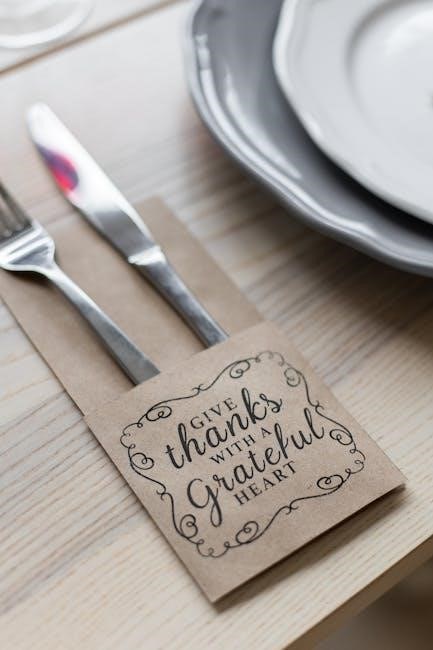Mastering knife sharpening angles is crucial for optimal blade performance․ The right angle enhances sharpness and durability, ensuring safety and efficiency․ Whether for chef knives, pocket knives, or hunting blades, understanding how steel hardness, blade thickness, and user preference influence the ideal angle is essential․ Achieving the perfect angle requires precision and consistency, making it a cornerstone of effective knife maintenance․ Learn how to determine and maintain the correct angle for your knife type, ensuring peak performance and longevity․
1․1 Why Sharpening Angles Matter
Sharpening angles are critical for achieving a knife’s optimal performance․ The angle determines the balance between sharpness and durability, directly impacting the knife’s cutting efficiency and edge longevity․ A lower angle creates a sharper but more fragile edge, while a higher angle results in a stronger, more durable blade․ Incorrect angles can lead to a dull or chipped edge, reducing the knife’s effectiveness and safety․ Understanding the right angle ensures the blade performs as intended, whether for precise cutting in cooking or robust use in outdoor activities․ Proper angles enhance user experience, making sharpening angles a foundational skill for knife enthusiasts and professionals alike․
1․2 Brief Overview of Common Knife Types
Common knife types include chef knives, Japanese knives, pocket knives, and hunting knives, each designed for specific tasks․ Chef knives, with their curved edges, excel in slicing and chopping, requiring precise angles for sharpness․ Japanese knives, known for their precision, often use lower angles for razor-sharp edges․ Pocket knives and folding blades prioritize durability, using slightly higher angles for robustness․ Hunting knives, designed for outdoor use, balance sharpness and strength with moderate angles․ Understanding these types helps in selecting the ideal sharpening angle, ensuring the blade performs optimally for its intended purpose․ Each knife type’s design and use influence the recommended angle, making this knowledge essential for effective sharpening․

Understanding the Importance of Sharpening Angles
Sharpening angles are crucial for balancing sharpness and durability, ensuring optimal knife performance for various tasks and blade types, and enhancing overall cutting efficiency effectively․
2․1 The Relationship Between Angle and Edge Sharpness
The sharpening angle directly impacts a knife’s edge sharpness and durability․ A lower angle creates a sharper edge but may compromise durability, making it prone to chipping․ Conversely, a higher angle results in a stronger, more robust edge but sacrifices some sharpness․ Finding the right balance is key to achieving optimal performance․ For general use, a 20-degree angle per side (40 degrees total) is often recommended, offering a durable yet sharp edge․ This balance ensures the knife performs effectively for its intended purpose, whether for precise cutting or heavy-duty tasks, making angle selection critical for both sharpness and longevity․
2․2 How Angle Affects Blade Durability
The sharpening angle significantly impacts a knife’s blade durability․ A lower angle, while enhancing sharpness, can make the edge more fragile, prone to chipping or rolling․ Conversely, a higher angle strengthens the edge, reducing susceptibility to damage but slightly compromising sharpness․ This trade-off is critical for knives used in demanding tasks․ For example, a 20-degree angle per side is often ideal for general use, balancing sharpness and durability․ Understanding this relationship helps users maintain their knife’s effectiveness and longevity, ensuring it performs reliably across various tasks without premature wear․
Factors Influencing the Optimal Sharpening Angle
Steel hardness, blade thickness, and user preference are key factors in determining the optimal sharpening angle․ Each influences the balance between sharpness and durability for specific tasks․
3․1 Steel Hardness and Its Impact on Angle
Steel hardness significantly influences the optimal sharpening angle․ Harder steels require a more precise, often narrower angle to achieve sharpness without chipping․ Softer steels may benefit from a slightly wider angle for durability․ A common starting point is 20 degrees per side, but adjustments are needed based on steel type․ For example, high-carbon steel knives might use a sharper angle for precision, while tougher, softer steels prefer a more robust edge․ Balancing sharpness and durability is key, as harder steels can be brittle at very sharp angles․ Always consider the steel’s hardness when selecting the ideal angle for your knife․
3․2 Blade Thickness and Edge Geometry
Blade thickness and edge geometry play a critical role in determining the optimal sharpening angle․ Thinner blades, such as those on chef or Japanese knives, often require a narrower angle to maintain sharpness and prevent chipping․ Thicker blades, commonly found in hunting or utility knives, benefit from a wider angle for added durability and resistance to wear․ The edge geometry, including the bevel and grind, also influences the angle selection․ A straight-edge knife may require a different approach compared to a serrated or recurve blade․ Balancing sharpness and strength is essential, as the angle must complement the blade’s design and intended use․
3․3 User Preference and Intended Use
User preference and intended use significantly influence the optimal sharpening angle․ For instance, chefs may prioritize a sharper edge for precision cutting, while hunters might favor a more durable edge for rugged tasks․ The angle should align with how the knife will be used, as this impacts both performance and longevity․ A knife used for delicate tasks may benefit from a narrower angle for sharpness, whereas a utility knife might require a wider angle for strength․ Personal preference also plays a role, as some users may compromise sharpness for durability based on their specific needs․ Matching the angle to the knife’s purpose ensures it meets the user’s expectations and enhances overall satisfaction․

Determining the Correct Sharpening Angle
Determining the correct sharpening angle involves considering the knife type, intended use, and steel hardness․ Start with a standard angle, like 20 degrees per side for general-purpose knives, and adjust based on personal preference and performance․ Use tools like a sharpening guide to maintain consistency and achieve better results․ This approach ensures the knife meets your specific needs, whether for sharpness or durability․
4․1 Methods to Identify the Ideal Angle
Identifying the ideal sharpening angle involves several methods․ Using a knife sharpening angle chart provides a quick reference for common blade types․ For visual guidance, draw the desired angle on cardboard and place it near your workspace․ Consider the knife’s intended use and steel hardness; harder steels often require slightly higher angles for durability․ Blade thickness also plays a role, with thinner edges benefiting from lower angles for sharpness․ Additionally, tools like angle guides or sharpening jigs can help maintain consistency․ Experimentation and practice are key to refining the angle for specific knives, ensuring optimal performance and longevity․
4․2 Using a Knife Sharpening Angle Chart
A knife sharpening angle chart is an invaluable tool for determining the ideal angle for your blade․ These charts typically categorize knives by type, such as chef, pocket, or hunting knives, and provide recommended angles for each․ For example, a chef knife might use a 20-degree angle per side, while a hunting knife could require a steeper angle for durability․ The chart also highlights the trade-off between sharpness and edge strength, with lower angles yielding sharper but more fragile edges and higher angles producing stronger but less sharp ones․ Referencing a sharpening angle chart ensures consistency and optimizes the blade’s performance for its intended use․
Maintaining Consistency in Sharpening Angles
Maintaining consistent sharpening angles is vital for optimal blade performance․ Use angle guides or marked tools to ensure precision․ Drawing the correct angles on cardboard near your workspace can serve as a handy reference, helping you achieve uniform results every time․
5․1 Tips for Consistent Angle Maintenance
To maintain consistent sharpening angles, use angle guides or marked tools for precision․ Drawing the correct angles on cardboard near your workspace can serve as a handy reference․ Start with coarse grit for initial shaping, then progress to finer grits for polishing․ Regular practice helps develop muscle memory, ensuring uniform results․ For added accuracy, consider using electric sharpeners with built-in angle controls․ Always match the angle to the knife type, as chef knives, pocket knives, and hunting blades have different requirements․ By following these tips, you can achieve consistent angles, enhancing both the sharpness and durability of your blades․

Common Mistakes to Avoid
Overlooking the importance of angle consistency and using incorrect tools are frequent errors․ Applying too much pressure can damage the blade, while ignoring angle checks leads to inconsistent results․
6․1 Overlooking the Importance of Angle
One of the most critical mistakes in knife sharpening is neglecting the significance of the sharpening angle․ The angle directly impacts the blade’s sharpness and durability, with lower angles producing sharper but more fragile edges, while higher angles result in stronger but less sharp edges․ Ignoring the recommended angle for a specific knife type can lead to inconsistent results, poor performance, and a shorter blade lifespan․ Many sharpening guides emphasize the importance of understanding and maintaining the correct angle, as improper technique can damage the knife or render it ineffective․ Using tools like angle guides can help prevent this common oversight․
6․2 Using Incorrect Tools for Angle Control
Using the wrong tools for angle control is a common mistake that can significantly hinder sharpening effectiveness․ For instance, relying on a whetstone without an angle guide can lead to inconsistent angles, resulting in a dull or uneven edge․ Similarly, using electric sharpeners without adjustable angle settings can damage the blade or fail to achieve the desired sharpness․ Proper tools, such as angle guides or sharpening jigs, are essential for maintaining precision․ Neglecting to use these tools can compromise the knife’s performance and longevity, emphasizing the importance of investing in the right equipment for accurate angle control during the sharpening process․

Tools for Achieving the Perfect Sharpening Angle
The right tools are essential for precise angle control․ Whetstones, electric sharpeners, and diamond stones are popular choices, each offering unique benefits for achieving sharp, durable edges consistently․
7․1 Whetstones and Water Stones
Whetstones and water stones are timeless tools for achieving precise sharpening angles․ They offer exceptional control, allowing for a razor-sharp edge while maintaining blade durability․ Water stones, like those in Blade Revival’s premium kit, are prized for their effectiveness in sharpening and honing․ Regular use ensures consistent results, making them ideal for both beginners and experts․ Proper maintenance, such as soaking and cleaning, extends their lifespan․ For added precision, drawing the correct angles on cardboard near your workspace can serve as a helpful guide․ These stones are versatile, suitable for various knife types, and are a cornerstone in any sharpening routine․
7․2 Electric Sharpeners and Angle Guides
Electric sharpeners with built-in angle guides are efficient tools for maintaining precise sharpening angles․ They offer ease of use, especially for beginners, ensuring consistent results․ These devices often feature adjustable settings to accommodate different blade types, from chef knives to hunting knives․ The angle guide helps prevent over-sharpening and maintains the ideal edge geometry․ Regular maintenance, such as cleaning the sharpening wheels, ensures longevity․ Electric sharpeners are ideal for those seeking convenience and accuracy, providing a reliable method to achieve sharp, durable edges․ They are particularly useful for users who struggle with manual sharpening techniques, making them a valuable addition to any sharpening toolkit․
7․3 Diamond Stones for Precision
Diamond stones are renowned for their precision in knife sharpening, offering exceptional control over angles․ Their durable, high-quality surfaces ensure consistent grit, making them ideal for advanced sharpening techniques․ Diamond stones are often used with angle guides to maintain precise edge geometry, especially for knives requiring specific angles, such as Japanese blades․ They are versatile, suitable for both straight and serrated edges, and provide a razor-sharp finish․ Regular use of diamond stones enhances blade longevity and sharpness․ For optimal results, pair them with a sharpening angle chart to identify the perfect angle for your knife type, ensuring a precise and durable edge every time․

Sharpening Techniques for Different Angles

Sharpening techniques vary based on desired angles, ensuring optimal edge performance․ Different methods are employed to achieve precise angles, enhancing both sharpness and blade longevity effectively every time․
8․1 Hand Sharpening with a Whetstone
Hand sharpening with a whetstone is a traditional and effective method for achieving precise angles․ Start by soaking the stone in water, then place the knife at the desired angle․ Lightly draw the blade across the stone, alternating sides with each stroke․ Maintain consistent pressure and angle to ensure an even edge․ For finer sharpening, switch to the stone’s finer grit side․ This technique allows for full control over the sharpening process, making it ideal for achieving specific angles․ Regular practice improves skill and results․ Always clean and dry the stone after use to maintain its effectiveness․

8․2 Using an Electric Sharpener
Electric sharpeners offer convenience and efficiency for maintaining precise angles․ These devices often feature preset angle guides, ensuring consistency with minimal effort․ Simply place the blade in the slot, select the desired angle, and draw it through․ The motorized wheels grind the edge evenly, making it ideal for beginners․ For sharper edges, use a lower angle, while higher angles enhance durability․ Regular use of an electric sharpener keeps knives in peak condition․ Always refer to the manufacturer’s guide for specific settings and maintenance tips to optimize results and extend the life of your blades․
8․3 Advanced Techniques for Specific Angles
Advanced sharpening techniques involve precision and customization for specific angles․ For instance, micro-beveling allows for fine-tuning the edge angle, enhancing sharpness without compromising durability․ Adjusting the angle based on steel hardness ensures optimal results, as harder steels benefit from slightly higher angles for longevity․ Additionally, techniques like edge profiling enable tailored sharpening for specialized tasks, such as filleting or chopping․ Using diamond stones or ceramic hones can refine the angle further, ensuring razor-sharp edges․ These methods require practice but offer unparalleled control over the sharpening process, making them ideal for enthusiasts and professionals seeking peak performance from their blades․

The Impact of Sharpening Angle on Blade Performance
The sharpening angle significantly affects a knife’s performance, balancing sharpness and durability․ A lower angle yields a sharper edge but compromises durability, while a higher angle enhances strength but reduces sharpness․
9․1 Sharpness vs․ Durability Trade-offs
The sharpening angle directly influences the balance between a knife’s sharpness and its durability․ A lower angle produces a sharper edge but makes it more prone to chipping or rolling, especially in thinner blades․ Conversely, a higher angle results in a stronger, more durable edge, though it may sacrifice some sharpness․ For general use, a 20-degree angle per side (40 degrees total) is often recommended as a compromise, offering both adequate sharpness and durability․ The choice depends on the knife’s intended use, with sharper angles suited for precision tasks and higher angles for rugged applications․ Understanding this trade-off is key to optimizing blade performance․
Sharpening Angles for Specific Types of Knives
Different knives require specific sharpening angles for optimal performance․ Factors like steel hardness and blade thickness guide the choice, ensuring sharpness and durability tailored to their use․
10․1 Chef Knives and Kitchen Blades
Chef knives and kitchen blades typically require a sharpening angle of 20 degrees per side, totaling 40 degrees․ This angle balances sharpness and durability, ideal for slicing and chopping․ Thinner edges, common in chef knives, benefit from slightly lower angles for precision, while thicker blades may use higher angles for robustness․ The 20-degree angle is a safe, versatile choice for general kitchen use, ensuring the knife remains sharp yet resistant to chipping․ Maintaining this angle is crucial for peak performance in demanding culinary environments, where both precision and durability are essential․
10․2 Japanese Knives and Precision Angles
Japanese knives, known for their precision, often require lower sharpening angles, typically between 15-20 degrees per side․ This finer edge enhances cutting performance, making them ideal for delicate tasks․ However, lower angles can make the blade more fragile, prone to chipping․ Gyuto and Santoku knives benefit from slightly higher angles for durability, while sushi knives may use even sharper angles for precision․ Maintaining these angles is critical for preserving the knife’s performance․ Using water stones or specialized sharpeners helps achieve and maintain the optimal angle, ensuring the blade remains sharp and functional for precise culinary work․
10․3 Pocket Knives and Folding Blades
Pocket knives and folding blades typically require a sharpening angle between 20-30 degrees per side, balancing sharpness and durability․ These knives are often used for everyday tasks, so a slightly higher angle ensures edge robustness․ A 25-30 degree angle is common, providing a strong edge that resists chipping․ For finer details, some users opt for a lower angle, but this may compromise durability․ Consistency is key, as uneven angles can affect performance․ Using a sharpening guide or marker helps maintain the correct angle․ Regular maintenance ensures the blade remains reliable for various practical applications, making it a versatile tool for everyday carry and use․
10․4 Hunting Knives and Outdoor Blades
Hunting knives and outdoor blades benefit from a slightly higher sharpening angle, typically between 25-35 degrees per side, to ensure durability for heavy-duty tasks․ These knives are often used for chopping, skinning, and cutting through tough materials, requiring a robust edge to withstand wear․ A higher angle provides strength and resistance to chipping, though it may sacrifice some sharpness․ For optimal performance, maintaining consistency in the angle is crucial․ Using a sharpening guide or marker can help achieve the desired angle․ This ensures the blade remains reliable for outdoor and hunting applications, where reliability is paramount․ Regular sharpening at this angle keeps the knife effective for its intended use․
Troubleshooting Common Angle-Related Issues
Identify and address angle-related problems like dull or chipped edges by adjusting sharpening angles․ Use guides or markers to maintain consistency and prevent future issues effectively․
11․1 Fixing a Dull or Chipped Edge
A dull or chipped edge often results from improper sharpening angles or inconsistent techniques․ To fix this, start by reassessing the angle and using guides or markers to maintain accuracy․ For chipped edges, gently re-sharpen the blade, focusing on the damaged area to restore the edge․ Begin with a coarse grit stone to remove chips and progress to finer grits for polishing․ Ensure the angle aligns with the knife’s intended use, as incorrect angles can exacerbate wear․ Regular maintenance and proper tool selection are key to preventing future issues․ Consistency and patience are essential for restoring a sharp, durable edge․
Mastering knife sharpening angles ensures optimal blade performance and longevity․ Consistency, proper tools, and practice are key to achieving sharpness and durability․ Sharpen with precision for lasting results․
12․1 Summary of Key Points
Knife sharpening angles are vital for achieving sharpness and durability․ The ideal angle depends on steel hardness, blade thickness, and intended use․ Lower angles yield sharper edges but may compromise durability, while higher angles provide strength but reduce sharpness․ Consistency is key to maintaining optimal performance․ Tools like whetstones, electric sharpeners, and angle guides help achieve precision․ For general use, a 20-degree per side angle is a reliable choice․ Proper techniques, such as hand sharpening or using advanced tools, ensure longevity․ Avoid common mistakes like ignoring angle importance or using incorrect tools․ By mastering these principles, users can enhance their knife’s performance and extend its lifespan effectively․
Additional Resources
Download a detailed knife sharpening angle chart PDF for precise guidance․ Explore tools like whetstones and electric sharpeners, plus tips for sharpening various knife types effectively․
13․1 Downloadable Knife Sharpening Angle Chart PDF
A downloadable knife sharpening angle chart PDF is a valuable resource for enthusiasts․ It provides precise angle recommendations for various knife types, ensuring optimal sharpness and durability․ Whether you’re sharpening a chef knife, Japanese blade, or pocket knife, this chart offers clear guidelines․ It covers factors like steel hardness, blade thickness, and intended use, helping you make informed decisions․ The chart also includes practical tips for maintaining consistency and avoiding common mistakes․ Perfect for both beginners and experienced sharpeners, it serves as a quick reference guide․ Download it for free and elevate your sharpening skills with detailed, easy-to-follow instructions tailored to your needs․
